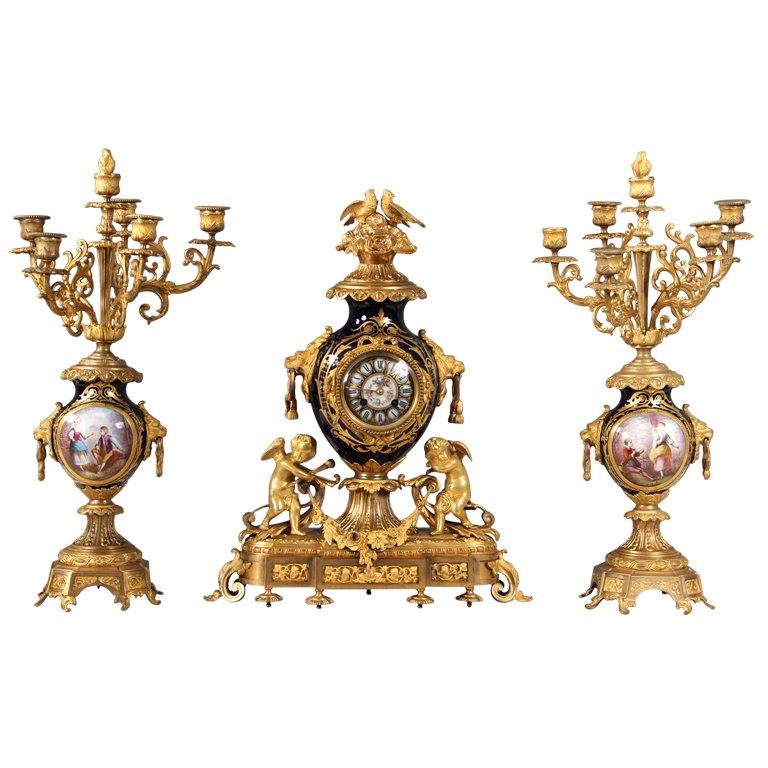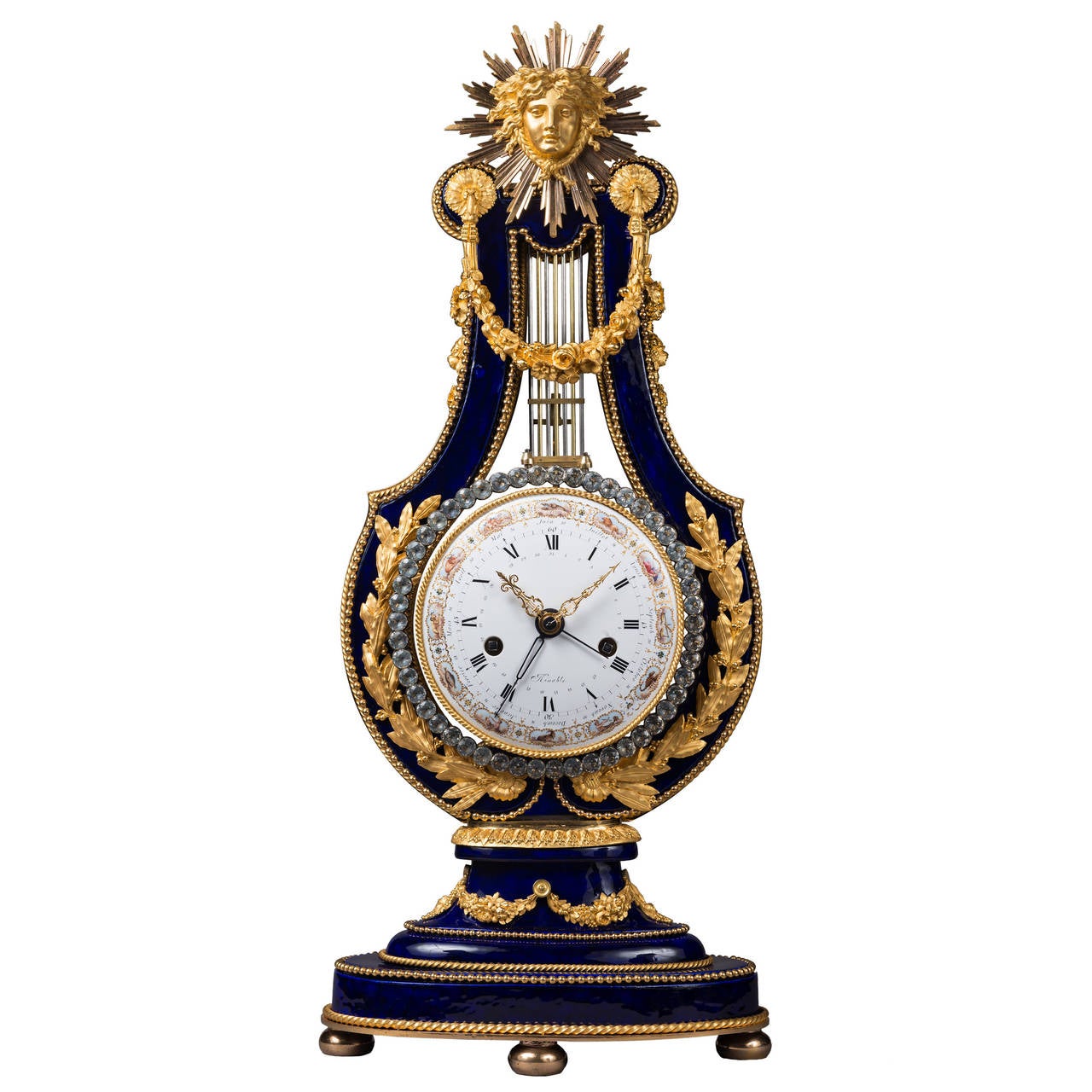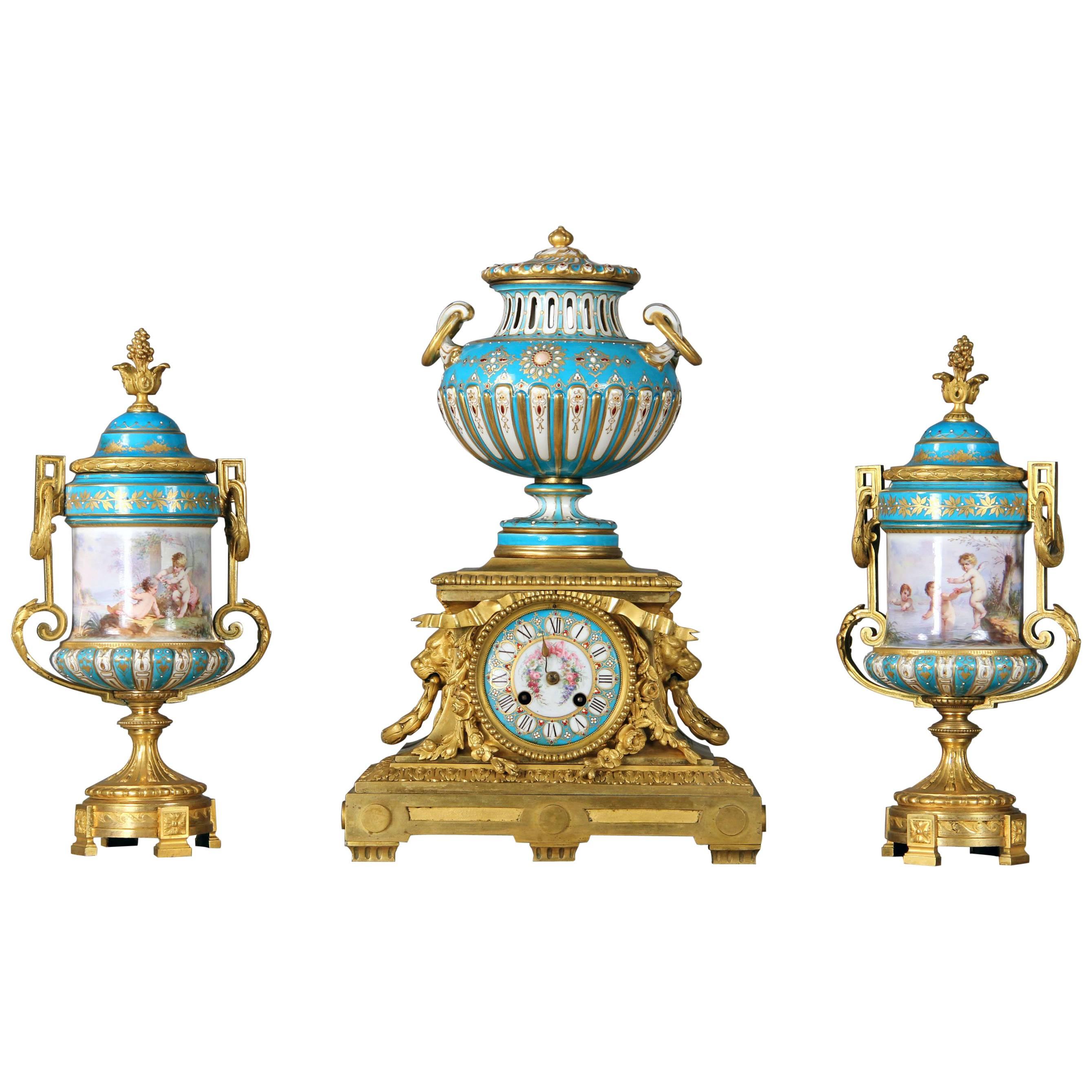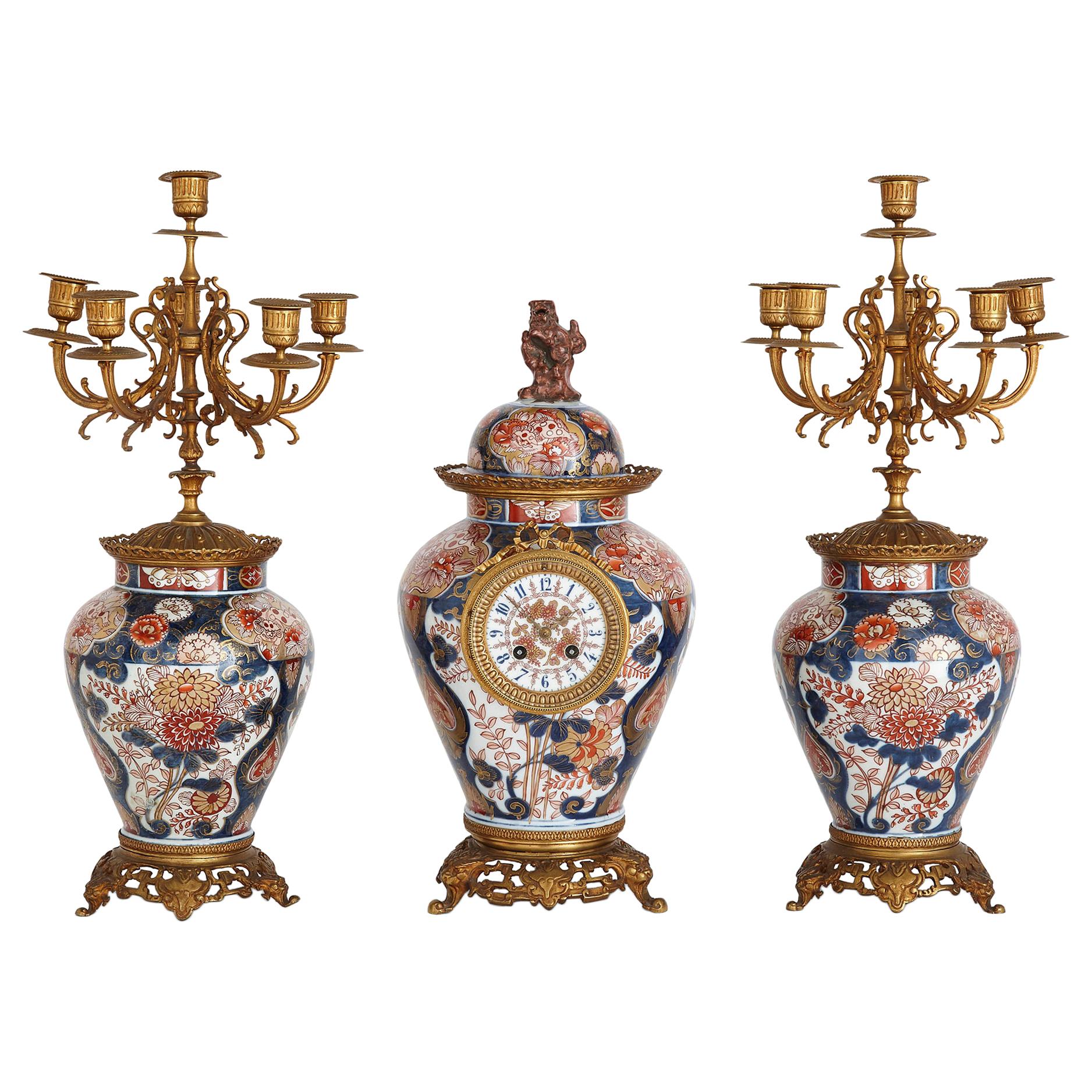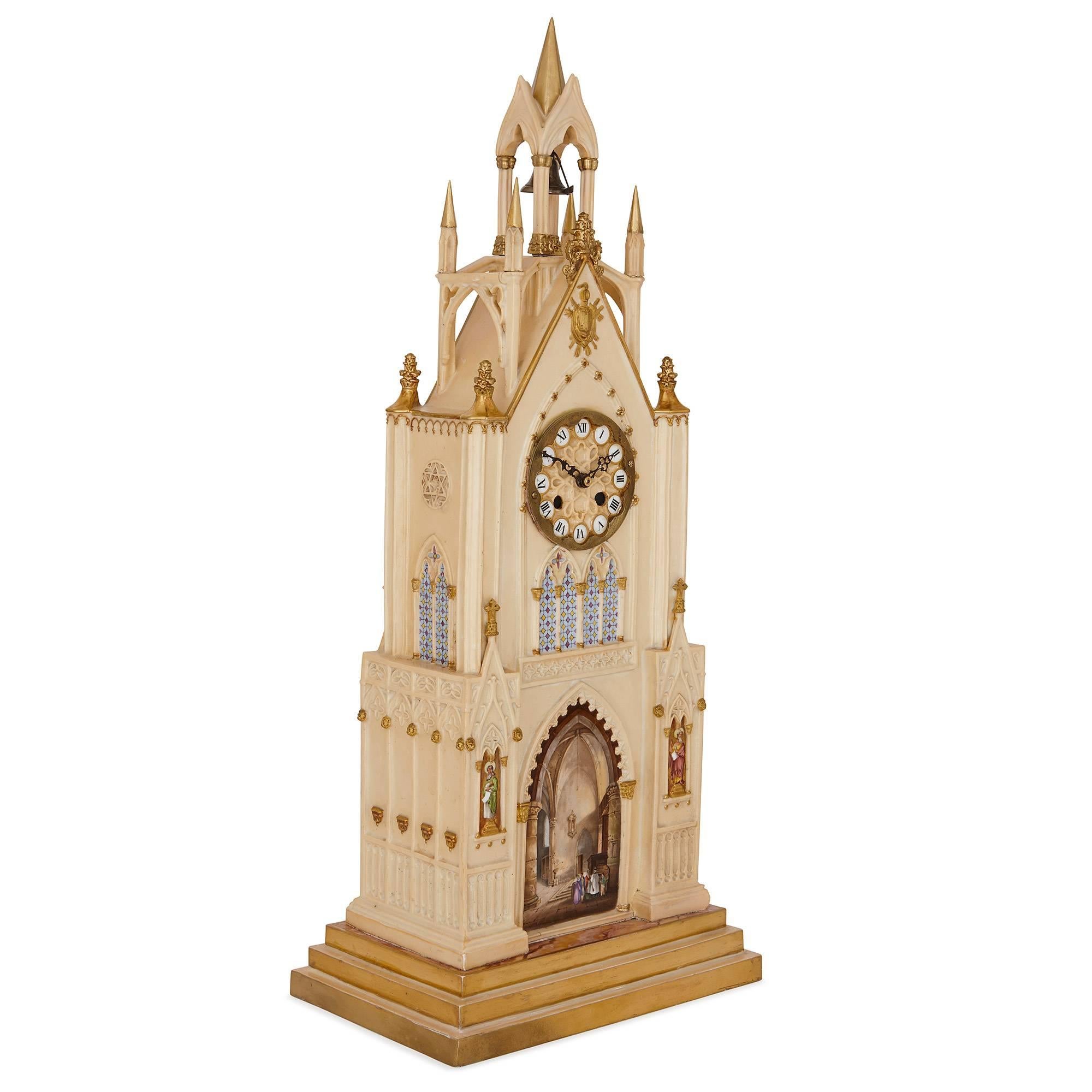Items Similar to Sèvres Porcelain 'Jeweled' Three-Piece Clock Set by Raingo Frères
Want more images or videos?
Request additional images or videos from the seller
1 of 7
Sèvres Porcelain 'Jeweled' Three-Piece Clock Set by Raingo Frères
About the Item
A wonderful and important mid-19th century gilt bronze and turquoise sevres porcelain 'Jeweled' three-piece clock set.
By Raingo Frères.
The clock surmounted by a covered urn with gilt porcelain handles, the clock face signed Raingo Fres A Paris, with two large gilt bronze cherubs on either side. Three porcelain plaques painted with scenes of putti at play on the bottom and sides. The two vases depict painted scenes of putti on the front and landscapes on the back, four plaques complete the bottom front, sides and back.
Raingo Frères
The clockmaker and bronzier Raingo Frères was founded in 1813 by Zacharie Joseph Raingo. He was born in 1775 in Belgium, lived in Tournai, was active in Ghent and moved to Paris in 1813. In Tournai, he probably made one of his first astronomical clocks with planetarium which was his specialty.
Raingo was named the "Watchmaker-Mécanicien" by the Duke of Orleans and "Watchmaker-Mécanicien du Garde-Meuble de la Couronne" (Supplier of the King of France) in 1824. King George IV of England bought a planetarium-clock of Raingo in 1824.
In 1834, the company received an honorable mention in an exhibition in Paris. While the four Raingo brothers were first recognized as clockmakers, in 1841 they added bronzes and furnishings to their repertoire. Known for the quality of their ormolu (gold plating), by 1860, Raingo Frères had furnished bronzes, garniture (decorations) and table pieces for the apartments of Emperor Napoleon III and his wife, the Empress Eugenia, examples of which are now in the collection of The Louvre. They later produced small models of works by contemporary artists, such as Pradier, Carrier-Belleuse and Auguste Moreau. They also collaborated with famous ebeniste François Linké.
In 1862, the company was present at the International Exhibition in London. In the world exhibitions in 1867, 1878 and 1889, the company also won several medals, even a Gold Medal in 1898. Some of their works are in different museums like Musée des Arts et Métiers in Paris, Museo Poldi Pezzoli in Milan and in Palacio Real de Madrid.
In late 1739-early 1740 the Sèvres Porcelain Factory opened in the Royal Château of Vincennes, 16 years later in 1756 the factory moved to the village of Sèvres located outside of Paris and in route to Louis XV's Palace of Versailles where it became the preeminent porcelain manufacturer in Europe. When the company ran into financial difficulties, the King who had become an avid client bought out the shareholders and became the sole owner. The factory remained in the royal family until it was nationalized following the French Revolution.
The range of objects produced in the first half of the 19th century was enormous, as were the types of decoration that they employed. The Sèvres factory produced ninety-two new designs for vases. The factory is still in production today.
Clock
Height: 23 inches / 58cm.
Width: 19 inches / 48cm.
Depth: 9 inches / 23cm.
Vases
Height: 19 inches / 48cm.
Width: 7 inches / 18cm.
- Creator:Raingo Frères (Clockmaker)
- Dimensions:Height: 23 in (58.42 cm)Width: 19 in (48.26 cm)Depth: 9 in (22.86 cm)
- Sold As:Set of 3
- Style:Belle Époque (Of the Period)
- Materials and Techniques:
- Place of Origin:
- Period:
- Date of Manufacture:circa 1860
- Condition:Wear consistent with age and use.
- Seller Location:New York, NY
- Reference Number:
About the Seller
5.0
Vetted Seller
These experienced sellers undergo a comprehensive evaluation by our team of in-house experts.
Established in 1924
1stDibs seller since 2010
70 sales on 1stDibs
Typical response time: <1 hour
Associations
The Art and Antique Dealers League of AmericaAntiques Associations Members
- ShippingRetrieving quote...Ships From: New York, NY
- Return PolicyThis item cannot be returned.
More From This SellerView All
- Late 19th Century Gilt Bronze Mounted Three Piece Sèvres Style Clock SetLocated in New York, NYLate 19th Century Gilt Bronze Mounted Three Piece Cobalt Blue Sèvres Style Clock Set Comprising: a round clock with a final with two birds; a pair of five-light candleabra with s...Category
Antique 19th Century French Clocks
MaterialsBronze
- Late 19th Century Gilt Bronze and Turquoise Sèvres Porcelain 'Jeweled' Clock SetBy Manufacture Nationale de SèvresLocated in New York, NYLate 19th century gilt bronze and turquoise Sèvres porcelain 'Jeweled' three-piece clock set The clock surmounted by a covered urn, the c...Category
Antique Late 19th Century French Belle Époque Mantel Clocks
MaterialsBronze
- Late 19th Century Gilt Bronze Mounted Parcel-Gilt and Biscuit Porcelain ClockLocated in New York, NYA beautifully design late 19th century gilt bronze mounted parcel-gilt and biscuit porcelain mantel (fireplace) clock The front carved with Apollo riding his chariot. The bottom w...Category
Antique Late 19th Century French Belle Époque Mantel Clocks
MaterialsBronze
- Exceptional Late 19th Century Three-Piece Clock Set by Ferdinand GervaisBy Ferdinand GervaisLocated in New York, NYAn exceptional late 19th century gilt bronze-mounted marble three-piece clock set By Ferdinand Gervais The lyre shaped case surrounded with bronze roses, acanthus and lilys, a ...Category
Antique Late 19th Century French Belle Époque Candelabras
MaterialsMarble, Bronze
- 19th Century Gilt and Patinated Bronze Three Piece Clock Set by Victor PierretBy Victor Athanase PierretLocated in New York, NYA fine mid-19th century gilt and patinated bronze three-piece clock set By Victor Pierret The figural clock of a woman and a bird seated next to a basket of roses above a gilded base designed with flowers. The candelabra with cherubs holding six lights and sitting on a gilt sea shell base...Category
Antique Mid-19th Century French Belle Époque Mantel Clocks
MaterialsBronze
- Nice Late 19th Century Gilt and Patinated Bronze Three Piece Clock SetLocated in New York, NYA nice late 19th century gilt and patinated bronze three-piece clock set. The heavily bronze mounted clock with three putti, bronze designs of flowers, birds and instruments, sitt...Category
Antique Late 19th Century French Belle Époque Table Clocks and Desk Clocks
MaterialsBronze
You May Also Like
- Sèvres Porcelain Louis XVI Lyre Mantel Clock by Kinable, Dial by DubuissonBy Dubuisson, Dieudonné KinableLocated in Paris, FRDieudonné Kinable Enamel Dial Attributed to Dubuisson (1731-1815) Exceptional Porcelain Lyre Mantel Clock from the Royal Sèvres Porcelain Manufactory Paris, late Louis XVI period, circa 1785-1790 Height 62 cm; width 26 cm; depth 16 cm The round enamel dial, signed “Kinable”, indicates the hours in Roman numerals, the fifteen-minute intervals in Arabic numerals, the annual calendar and the signs of the Zodiac, by means of four hands, two of which are made of pierced gilt bronze, the two others in blued steel. The magnificent lyre-shaped case is made of “bleu nouveau” Sèvres porcelain and finely chased and gilt bronze. The bezel is made up of a gilt bronze twisted rope; the pendulum is adorned with brilliant-cut paste stones; the body of the lyre is adorned with gilt bronze beading and with laurel leaf and seed motifs, with two rosettes issuing floral and foliate swags. The clock is surmounted by a mask with radiating sunrays. The spreading foot is decorated with beading and twisted rope motifs and a leafy garland. The en-suite decorated oval base is raised upon four flattened ball feet. The Royal Sèvres Porcelain Factory produced the lyre clock model as of 1785. Four colours were offered: turquoise, green, pink and bleu nouveau. These exceptional clocks were made for the connoisseurs of the time. Louis XVI had a similar clock in his Salon des jeux in Versailles; its dial bore the signature of the clockmaker Courieult (this is almost certainly the example illustrated in P. Verlet, Les bronzes dorés français du XVIIIe siècle, Paris, 1999, p. 41). Kinable, however, was the clockmaker who purchased the greatest number of lyre cases from the factory, and he developed the model in the late 18th century. Among the porcelain lyre clocks signed by this brilliant horologer, one example is in the Victoria & Albert Museum in London (illustrated in H. Ottomeyer and P. Pröschel, Vergoldete Bronzen, Band I, Munich, 1986, p. 252, fig. 4.6.26). A second such clock is in the Royal British Collection (see C. Jagger, Royal Clocks, The British Monarchy & its Timekeepers 1300-1900, 1983, p. 130, fig. 176). Bibliography: M. Gay and A. Lemaire, “Les pendules lyre”, in Bulletin de l’Association nationale des Collectionneurs et Amateurs d’Horlogerie ancienne, Winter 1993, n° 68, p. 5-40. Dieudonné Kinable (active circa 1785-1810) One of the most important Parisian clockmakers of the late 18th century. His shop was located at n° 131 Palais Royal. He purchased a great number of lyre-type porcelain clock cases...Category
Antique 1780s French Louis XVI Mantel Clocks
MaterialsBronze
- Antique Three-Piece Meiji Period Japonisme Vase Clock SetLocated in London, GBAntique three-piece Meiji period Japonisme vase clock set French/Japanese, late 19th century Measures: Clock height 47cm, diameter 22cm Candelabra height 55cm, width 25cm, depth 2...Category
Antique Late 19th Century French Japonisme Mantel Clocks
MaterialsOrmolu
- French Porcelain Mantel Clock by Dagoty and HonoreBy Dagoty, Edouard Honoré 1Located in London, GBThis beautiful Gothic Revival style porcelain clock was made by the prestigious French firm Dagoty and Honore, founded by the esteemed porcelain makers Pierre-Louis Dagoty and Edouard Honore...Category
Antique Early 19th Century French Gothic Revival Mantel Clocks
MaterialsPorcelain
- Antique Gothic Revival Porcelain Clock by Dagoty & HonoréBy DagotyLocated in London, GBAntique Gothic Revival porcelain clock by Dagoty & Honoré French, c. 1830 Measures: Height 51cm, width 25.5cm, depth 17cm This beautiful Gothic Revival style porcelain clock was made by the prestigious French firm Dagoty and Honoré, founded by the esteemed porcelain makers Pierre-Louis Dagoty and Edouard Honoré...Category
Antique Early 19th Century French Gothic Revival Mantel Clocks
MaterialsPorcelain
- Meissen Porcelain Strut Mantel ClockBy Howell James & Co.Located in Norwich, GBA Meissen porcelain oval shaped Strut clock with two putti and well modelled trailing flowers and wreath decoration. (The back of the case at 12 o’clock carrying the crossed swords m...Category
Antique 1870s English Victorian Mantel Clocks
MaterialsPorcelain
- Porcelain Clock in the Louis XV Style by Jacob PetitBy Jacob PetitLocated in London, GBThis antique porcelain mantel clock demonstrates the 19th century nostalgia for the delicately elegant decorative arts under King Louis XV, also known as the Rococo style. Crafted by celebrated porcelain artist Jacob Petit, this exquisite clock is particularly notable for the way in which the porcelain has been shaped so as to give the clock such a whimsically free-spirited, scrolling shape. The clock is formed as a clock case upon a lower base, which are both decorated as a though a singular piece with green glaze on a white ground, accented with painted floral panels and extensive gilt highlights all over. The clock case, which is particularly exuberant in design, features a central, circular clock dial. The white enamelled dial is bordered with beaded ormolu, and features black Roman numerals and the inscription 'Scherer'- the name of the 19th century Parisian clock...Category
Antique 19th Century French Rococo Mantel Clocks
MaterialsPorcelain
Recently Viewed
View AllMore Ways To Browse
An Antique Clock
Antique Clocks For
Gold Clock
Small Clock
Set Of Clocks
Antique Gold Clock
Decorative Medal
Medal Decorative
Clocks New
Clock Face Antique Clocks
Clock Faces Antique Clocks
Antique Clock Face Antique Clocks
Two Antique Clocks
Hes Clock
Antique Furniture Three Piece Set
Quality Antique Clocks
Gold Clock Set
World Clock
